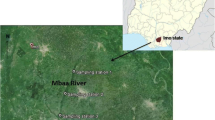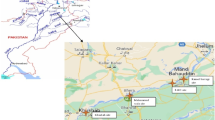Abstract
This study focused on the analysis of metals in water and fish from Nairobi River. Water from Kikuyu, Kawangware, Chiromo, Eastleigh, Njiru and Fourteen Falls along the Nairobi River was analyzed for the presence of metals. Most of the metal levels in water were below the critical limit of World Health Organization and Kenya Bureau of Standards except for lead, chromium, iron and manganese. Isolated cases of mercury and aluminium pollution were recorded. Except for iron, sodium and potassium, there was no significant difference in the concentration of metals at different sites. This study also analyzed metal levels in fish organs and tissues of fish caught from downstream (Fourteen Falls). The highest zinc concentration (360 μg/g) was in the scales, copper recorded the highest concentration in the kidney (45 μg/g), while cadmium recorded high values (167 μg/g) in the heart. Lead recorded high values (178 μg/g) in the heart and mercury recorded high values also in the heart (1000 ng/g). Most of these organs, are however, not eaten by man as food. Although metal levels were within normal levels in the water at Fourteen Falls, mercury, copper, lead and iron recorded higher than accepted levels in some fish organs. This calls for caution in the consumption of fish from Fourteen Falls.
Similar content being viewed by others
References
Allen, E. S.: 1989, Chemical Analysis of Ecological Materials, Blackwell Scientific Publications, Oxford, pp. 1–291.
American Public Health Association (APHA): 1989, Standard Methods for the Examination of Water and Wastewater.
Baudo, R.: 1989, ‘Heavy metal pollution and ecosystem recovery’, in O. Ravera (ed.), Ecological Assessment of Environmental Degradation: Pollution and Recovery, Elsevier Science Publishers, Amsterdam, pp. 325–352.
Costa, M.: 1997, ‘Toxicity and carcinogenicity of Cr VI in animal models and humans’, Crit. Rev. Toxicol. 27, 431–442.
Edward, W. C. and Dooley, A. L.: 1981, ‘Heavy and trace metal determination in cattle grazing pastures fertilized with treated Raffinate’, Ver. Hum. Toxicol. 22, 309–311.
Ewers, U. and Schlipöter, H.-W.: 1991, ‘Lead’, in Merian E. (ed.), Metals and Their Compounds in the Environment – Occurrence: Analysis and Biological Significance, Verlagsgesellschaft, Weinheim, Germany, pp. 971–1014.
Hapke, H.-J.: 1991, ‘Metal accumulation in the food chain and load of feed and food’, in Merian E. (ed.), Metals and Their Compounds in the Environment – Occurrence: Analysis and Biological Significance, Verlagsgesellschaft, Weinheim Germany, pp. 469–479.
Kenya Bureau of Standards (KBS): 1996. Kenya standard. Specification for drinking part 1, The requirement for drinking water and containerized drinking water.
Kinchella, C. E. and Hyland M. C.: 1993, ‘Water pollution’, in C. E Kinchella and M. C. Hyland (eds.), Environmental Science: Living Within the System of Nature, pp. 337–380.
Moore, J. W. and Ramamoorthy, S.: 1984, Heavy Metals in Natural Waters: Applied Monitoring and Impact Assessment, Springer-verlag, New York, pp. 1–268
Mwachiro, E. C. and Durve, V. S.: 1997, ‘Heavy metal status of the reservoir Bari near Udaipur (Rajasthan) and the accumulation of the metals in fish organs’, Poll. Res. 16(2), 67–74.
Ndwaru, W.: 1994, ‘Findings of the pollution survey and the need for pollution control’, Proceedings of the Workshop on Abatement of Pollution in Nairobi Rivers, pp. 15–18.
Nies, D. H.: 1999, ‘Microbial heavy metal resistance’, Appl. Microbiol. Biotechnol. 51, 730–750.
Okoth, P. F. and Otieno, P.: 2001, Pollution Assessment Report of the Nairobi River Basin, UNEP. AWN, Nairobi, pp. 106.
Otieno, F. A. O.: 1995, Role of industries in sustaining water quality, 21st WEDC Conference, Sustainability of water and sanitation systems, pp. 144–147.
Powell, A. K.: 1993, ‘Models for iron biomolecules’, in J. Silver (ed), Chemistry or Iron, Blackie Academic and Professional, London, pp. 244–274.
Richardson, C. J., DiGiulio, R. T. and Tandy, N. E.: 1989, ‘Free radical mediated processes as makers of air pollution stress in trees’, in Committee on biologic makers of air pollution damage in trees (ed), Biological Makers of Air Pollution Stress and Damage in Forest, National Academic Press, Washington, DC, pp. 251–260.
Thompson, J. D. and Nechay, B. R.: 1981, ‘Inhibition by metals of canine renal calcium, magnesium activated adenosine triphosphatase’, J. Toxicol. Env. Hlth. 7, 901.
Tyagi, O. D. and Mehra, M.: 1992, Environmental Chemistry, Anmol Publications, New Dehli, pp. 109–288.
Von Burg, R. and Greenwood, R.M.: 1991, ‘Mercury’, in E. Merian (ed), Metals and Their Compounds in the Environment – Occurrence: Analysis and Biological Significance, Verlagsgesellschaft, Weinheim, Germany, pp. 1045–1053.
Ward, N. I.: 1987. ‘The future of multi-element analysis’, Environ. Health 20, 118–123.
William, S. and Hook, J. B.: 1977, ‘Renal functional correlation of methyl mercury intoxication interaction with acute mercuric chloride toxicity’, Toxicol. Appl. Phom. 42, 399.
WHO: 1985, Guidelines for Drinking Water Quality, Vol. 3, Drinking Water Quality Control in Small Community Supplies, Geneva, 121.
Author information
Authors and Affiliations
Corresponding author
Rights and permissions
About this article
Cite this article
Budambula, N.L.M., Mwachiro, E.C. Metal Status of Nairobi River Waters and Their Bioaccumulation in Labeo Cylindricus . Water Air Soil Pollut 169, 275–291 (2006). https://doi.org/10.1007/s11270-006-2294-x
Received:
Accepted:
Issue Date:
DOI: https://doi.org/10.1007/s11270-006-2294-x




